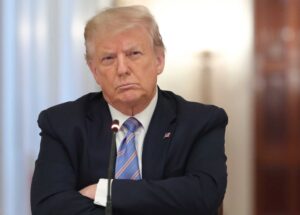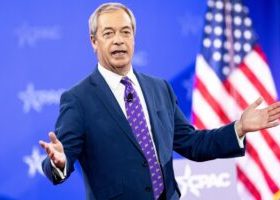
The US economy shrank by 0.3% in the first quarter of 2025, marking its first contraction in over two years, as businesses rushed to import goods ahead of President Trump’s sweeping tariff plans, triggering record trade imbalances and unsettling financial markets.
The latest data from the US Bureau of Economic Analysis (BEA) shows the economy sliding into negative territory after 2.4% growth in the final quarter of 2024, and performing worse than the 0.2% decline expected by analysts. It follows a frenzied build-up of imports, which surged 41.3% on an annualised basis as companies moved to stockpile goods ahead of new tariffs.
Because imports are subtracted from GDP in national accounting, the record goods trade deficit in March weighed heavily on growth, even as underlying domestic demand remained relatively stable.
“Importers desperately tried to bring in as many goods as possible ahead of tariffs,” said James Knightley, chief international economist at ING.
“This surge now appears to be reversing, which could give a boost to second-quarter GDP,” added Paul Ashworth of Capital Economics.
Despite the contraction, Wall Street showed resilience. After opening sharply lower, the Dow Jones closed up 141 points, with more muted gains for the S&P 500 and a slight drop for the Nasdaq, which recovered from steeper early losses.
Trump’s aggressive “reciprocal tariff” plan, announced on April 2, has cast a long shadow over the US and global economy. Although implementation of the full package has been delayed by 90 days, the administration has retained a 10% blanket tariff, a 145% charge on Chinese goods, and levies on sensitive imports including cars and metals.
In a Truth Social post, Trump denied that tariffs had caused the contraction:
“This is Biden’s Stock Market, not Trump’s… This will take a while, has NOTHING TO DO WITH TARIFFS… but when the boom begins, it will be like no other.”
However, investment banks including JP Morgan, Goldman Sachs, and BNP Paribas have all downgraded US growth forecasts. JP Morgan has now placed a 60% probability on the US slipping into recession.
Adding to the drag was a decline in government spending, linked to cuts overseen by the Department of Government Efficiency (DOGE) under Elon Musk, which has reduced public sector headcount.
Further complicating the outlook, inflation pressures are building. The core personal consumption expenditures (PCE) index, the Federal Reserve’s preferred inflation gauge, rose to 3.5% in Q1, up from 2.6%, and significantly above expectations.
Though monthly PCE data is more closely tracked, the quarterly jump signals that inflation was already accelerating before the steeper tariffs hit in April — potentially limiting the Federal Reserve’s room to cut rates.
In contrast, the eurozone economy posted 0.4% growth in Q1, beating forecasts and helped by aggressive interest rate cuts from the European Central Bank and the announcement of a €500 billion investment plan by incoming German chancellor Friedrich Merz.
Germany returned to growth, expanding by 0.2%, and France narrowly avoided a technical recession with 0.1% growth. However, analysts warn the boost may be temporary.
“The report does not take into account the ‘Liberation Day’ shock and the significant uncertainty that follows,” said Christophe Boucher, CIO at ABN Amro Investment Solutions.
Trump has indicated that the EU will face a 20% import tax under his full plan, though for now the bloc is only subject to the 10% baseline tariff.
With growth slowing, inflation rising, and trade policy in flux, economists say the Fed and global central banks face a tough balancing act. Meanwhile, the Bank of England is expected to begin cutting rates rapidly to offset the global drag from tariffs.
The US downturn — however temporary — underscores the real-world risks of protectionism, even before the bulk of Trump’s tariffs fully take effect. Whether Q1 proves to be a blip or the start of a broader slowdown may depend on whether further trade escalation is avoided. For now, uncertainty remains the only certainty.
Read more:
US economy contracts for first time since 2022 as Trump tariffs unsettle markets






